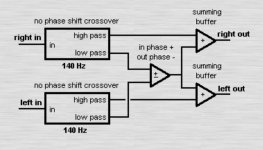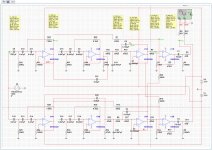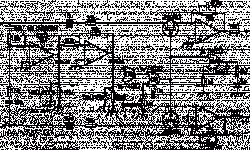The bessel filter is necessary to minimize phase shifts. I haven't done much looking into the effects of this though.
Looks like one of the best way to do this is to use a Linkwitz Riley crossover with the lower frequency output summed together and then combined back in with the high frequency output in separate summing amplifiers for each channel. Even when you've done that you'll still need another steep filter to remove lateral rumble at 15Hz or so.
However a better idea might be to simply construct a DIFFERENTIAL high pass filter between the two channels, say 24dB/octave Bessel? Would certainly cut down on complexity.
Looks like one of the best way to do this is to use a Linkwitz Riley crossover with the lower frequency output summed together and then combined back in with the high frequency output in separate summing amplifiers for each channel. Even when you've done that you'll still need another steep filter to remove lateral rumble at 15Hz or so.
However a better idea might be to simply construct a DIFFERENTIAL high pass filter between the two channels, say 24dB/octave Bessel? Would certainly cut down on complexity.
I think the circuit I came up with in 2012 is clumsy and should be scrapped TBH, it was purely experimental.
I'd love to direct the discussion towards coming up with a few good topologies (and ultimately full blown circuits). Remember that summing amplifiers are inherently noisy.
Lets see how elegantly we can do this!
I'd love to direct the discussion towards coming up with a few good topologies (and ultimately full blown circuits). Remember that summing amplifiers are inherently noisy.
Lets see how elegantly we can do this!
I have one of "these" in my preamp collection The Derumbleizer cancels rumble 3 octaves higher than any filter
...
Ah, ha! Here's another bass processor rather than 'just' a filter

from:
The Derumbleizer cancels rumble 3 octaves higher than any filter
PS Hey Monty, can you describe your two ideas a bit more (or even make flow charts like this?)
Last edited:
OK, here's a off the top of my head schematic for the differential filter derumbler. First it has a 24dB/ocatve Bessel filter between the two channels filtering the LF out of the stereo difference. The resistors to the opposing channel on this filter should be grounded via a very high value resistor to give the opamps their bias current. This should be set to about 150Hz or so.
Next is a 36dB per octave conventional high pass Butterworth filter to remove the lower frequency rumble set to perhaps 15Hz or maybe even 20Hz.
I have yet to evaluate whether or not this will cause any phase issues, perhaps a crossover veteran could give some advice ?
?
This works out to be quite simple, although I've omitted the input buffers and output decoupling.
To be quite honest I'm not mad keen on summing and differential amplifiers they would add to noise and complexity IMO. My idea for using a Linkwitz Riley crossover and summing the lower frequencies is pretty much the same as the block diagram you have presented.
Next is a 36dB per octave conventional high pass Butterworth filter to remove the lower frequency rumble set to perhaps 15Hz or maybe even 20Hz.
I have yet to evaluate whether or not this will cause any phase issues, perhaps a crossover veteran could give some advice
This works out to be quite simple, although I've omitted the input buffers and output decoupling.
To be quite honest I'm not mad keen on summing and differential amplifiers they would add to noise and complexity IMO. My idea for using a Linkwitz Riley crossover and summing the lower frequencies is pretty much the same as the block diagram you have presented.
Attachments
Well, the Self approach you describe only works when the input is being fed into a power amplifier that can only handle a volt or two at it's input before clipping occurs. In this application we want all the headroom we can get as transient clipping is a major bugbear in most phono stages.
If sensible resistor values are chosen then noise won't be a major problem but it'll be far higher than in the topology I just posted. Circuit complexity will also be higher, meaning more components, more build time, larger physical size and higher power requirements.
If sensible resistor values are chosen then noise won't be a major problem but it'll be far higher than in the topology I just posted. Circuit complexity will also be higher, meaning more components, more build time, larger physical size and higher power requirements.
It's just not good practice as it reduces headroom which is never good unless that headroom genuinely won't be used (as in Douglas Self's crossover). This is especially true if you are planning on using supply rails less than the 15V commonly used. I use 16.6V as it can be done with simple 317/337 power supplies and E12 values.
Hi. This thread is fantastic and thanks to monty78pig and all the contributors I've learned more about the record recording practice that I had not previously known. Since I've been playing with my own phono preamp circuits lately this is awesome info for me.
Have you considered a version of this which keeps the left and right channels electrically isolated? For example I could possibly see passing transformer (likely big ones to be effective at infra bass frequencies) isolated error signals to accomplish similar results.
The approach that has worked best for me in my system, because my computer is so noisy and I like to use it to rip my records, I have found it necessary to use a single point ground in my system where the computer is that point. This requires me to eliminate the ground loops that would be formed by using a preamp which shares left and right channel grounds.
The other thing is monty78pig approach might seem really interesting to someone already planing to implement software RIAA correction. Are any of the computer vinyl software commercial offerings doing this kind of thing in digital???
Edit
Have you considered a version of this which keeps the left and right channels electrically isolated? For example I could possibly see passing transformer (likely big ones to be effective at infra bass frequencies) isolated error signals to accomplish similar results.
The approach that has worked best for me in my system, because my computer is so noisy and I like to use it to rip my records, I have found it necessary to use a single point ground in my system where the computer is that point. This requires me to eliminate the ground loops that would be formed by using a preamp which shares left and right channel grounds.
The other thing is monty78pig approach might seem really interesting to someone already planing to implement software RIAA correction. Are any of the computer vinyl software commercial offerings doing this kind of thing in digital???
Edit
Last edited:
.Rumble is something that has always irritated me and I have always been dissatisfied with the standard cascaded high pass filter type designs.
One of my many hobbies is restoration, mostly dead mono 78s, but sometimes the odd LP. If the disc is even slightly warped, then the rumble immediately shows up on the waveform and it seems impossible to reduce it to a good level without affecting the audio. Even with a 160dB/Decade filter at 20Hz or so, I can still see the bass drivers in my RX6's quivering, this is (to me) intolerable. The fluttery effect on the stereo image that it causes is horrible
.
However, when using mixing the stereo track down to mono, this dissapears almost completely (all thats left is some very low frequency noise <8Hz), along with the low frequency 'road noise' sound. 95% of this crap seems to lie in the stereo separation (vertical plane of the stylus' movement).
By experimenting with the filters and effects in Audacity on some quick transfers I have found that:
Firstly, virtually no discs have any real stereo separation below about 200Hz or so at most, this means that I can lose the separation at, say, 150Hz without any change to the original audio. By splitting the channels at this frequency with 40dB/Decade filters and then mixing the two low frequency tracks together the rumble can be almost completely eliminated with far greater effectivity than just using a high pass filter. It will cancel rumble of far far higher frequencies than just a high pass filter ever could. No more 'road noise'!
Secondly, after this has been applied, the remaining rumble is of very low frequency, and a simple 40dB/decade filter at 12Hz does the job wonderfully. After this has been applied, the rumble becomes invisible on the waveform (and more importantly inaudible), as opposed to simply having the subsonic elements attenuated when using a high pass filter. This filter really works wonders at reducing low frequency surface noise well above 100Hz.
I have incorporated my findings into a circuit that will sit between my phono preamp and control amp (see attached) although a little more complicated than a steep subsonic filter, the extra complexity is well worth it. The circuit applies an 60dB/Decade filter at 12Hz, and collapses the stereo image below 160Hz. When using these filters on Audacity the rumble is reduced by about 24dB at 20Hz.
I'd be interested to hear peoples ideas on this concept, so tell me what you think. I'm still experimenting so will keep this thread posted with my results.
Question?
See circuit, U2L - inverse and non-inverse input must changeover among themselves ? Or not ?
I think, this is a mistake on circuit.
.
.I'd be interested to hear peoples ideas on this concept, so tell me what you think. I'm still experimenting so will keep this thread posted with my results.
Trying to simulate first circuit.
Result is good.
But have some problems and questions about circuit.
.
.OK so here are some values I've worked out. The bottom and top half of the circuit are mirror images of themselves R3 and R6 satisfy the need for op-amp offset current while ensuring that the filter remains almost purely differential.
Questions about ciecuit.
.
Frequency of Bassel filter ?
Frequency of Batterworthe filter ?
.
The idea of 'mono-ising' LF resurfaces from time to time. The record itself will have had this treatment, so if done carefully most of what you are throwing away will be noise rather than signal.
A simpler version can be achieved by adding a cross-channel resistor at the right point in the RIAA network in a phono preamp. This only gives 6dB/octave LF mixing, but it might be enough for warped LPs.
Hi,
Could you tell where this would be?
- Status
- This old topic is closed. If you want to reopen this topic, contact a moderator using the "Report Post" button.
- Home
- Source & Line
- Analogue Source
- The ultimate rumble filter - far more effective than just a high pass filter!



